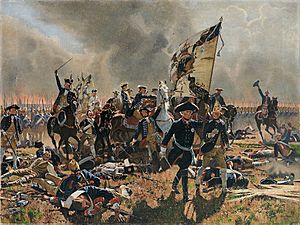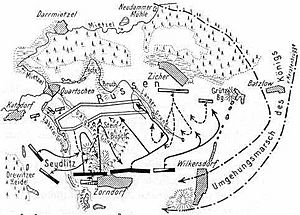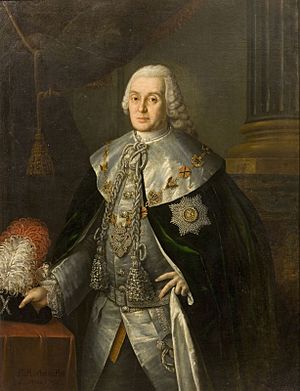Battle of Zorndorf facts for kids
Quick facts for kids Battle of Zorndorf |
|||||||
|---|---|---|---|---|---|---|---|
| Part of the Third Silesian War (Seven Years' War) | |||||||
 Frederick the Great at the Battle of Zorndorf by Carl Röchling |
|||||||
|
|||||||
| Belligerents | |||||||
| Commanders and leaders | |||||||
| Strength | |||||||
| 36,000 167 guns |
42,590 210 guns |
||||||
| Casualties and losses | |||||||
| 11,390–12,800 3,680 killed 7,710 wounded or missing |
16,000 30 guns 27 flags |
||||||
The Battle of Zorndorf was a major fight during the Seven Years' War. It happened on August 25, 1758. The battle was between the Russian army, led by Count William Fermor, and the Prussian army, led by King Frederick the Great.
The battle took place near the Prussian village of Zorndorf. Today, this area is called Sarbinowo in Poland. Both sides fought hard, and neither army completely won. They both stayed on the battlefield and claimed victory. During the battle, King Frederick even grabbed a regimental standard (a flag) and led his soldiers himself to encourage them.
Contents
The Seven Years' War: A Global Conflict
The Seven Years' War was a huge global conflict, but it was especially intense in Europe. This war followed another big conflict called the War of the Austrian Succession (1740–1748). At the end of that war, in 1748, a peace treaty was signed. This treaty gave Frederick II of Prussia, also known as Frederick the Great, a rich area called Silesia. He had won it in earlier wars.
Why the War Started Again
Empress Maria Theresa of Austria signed the peace treaty to gain time. She wanted to rebuild her army and find new friends (allies). Her main goal was to get back control in the Holy Roman Empire and to take Silesia back from Prussia.
Around 1754, problems between Britain and France grew in North America. France saw this as a chance to challenge Britain's power in trade. Austria then decided to team up with France, even though they used to be enemies. This was a big change in alliances. Britain, seeing this new team-up, joined forces with Prussia. This shift in alliances is known as the Diplomatic Revolution.
Prussia's Strong Army and Early Victories
When the war began, Frederick had one of the best armies in Europe. His soldiers could fire their guns very quickly, up to five times a minute. By the end of 1757, Prussia was doing well in the war, while Austria was struggling.
Prussia won big battles at Rossbach and Leuthen. They also took back parts of Silesia that Austria had captured. Prussia then moved into Austrian territory. In 1758, Britain agreed to pay Frederick a large amount of money each year to help him. Britain also sent soldiers to help Frederick's brother-in-law, the Duke Ferdinand of Brunswick-Wolfenbüttel.
Ferdinand pushed the French out of some areas and captured a port. He even crossed the Rhine River, which worried France. Even though Ferdinand won a battle against the French, he had to pull back because the French had more soldiers.
Russia Joins the Fight
After a battle in 1757, the Prussians were pushed out of Bohemia. Empress Maria Theresa of Austria thought things were looking up for her. But then Frederick won against the French and then the Austrians.
In August 1758, Russia, an ally of Austria, invaded East Prussia. About 42,590 Russian soldiers, led by William Fermor, got very close to Berlin, the capital of Prussia. They planned to join up with the Austrian army. King Frederick knew that if his enemies joined forces, Berlin would fall. So, he decided to stop them. He moved his army behind the Russians.
Fermor, who was attacking a Prussian town, found out about Frederick's move. He stopped his attack and took up a position at Zorndorf, about 10 kilometers (6 miles) northeast of the town he was attacking. By late summer, the fighting was at a standstill. None of Prussia's enemies seemed ready to attack deep into Prussia.
While Ferdinand kept the French busy, Prussia had to fight Sweden, Russia, and Austria. Frederick was worried that Prussia could lose important lands to these enemies. By 1758, Frederick was very concerned about the Russian army coming from the east. He marched his army to meet them. East of the Oder river, a Prussian army of 36,000 men faced a Russian army of 42,590 at Zorndorf on August 25, 1758.
The Battlefield at Zorndorf
Zorndorf was a small village in a very wet, marshy area. It had scattered fir trees, open heathland, and small patches of farmed land. In the 1700s, this area was full of bogs and swamps. It was very hard to move through.
The land was described as having "leakages" – wide, muddy areas with slow-moving streams and still pools. Zorndorf itself was located at the edge of this difficult, almost impassable terrain. This made it very tricky for armies to move and plan their attacks.
The Battle Unfolds
On August 25, Frederick's foot soldiers attacked a group of young Russian recruits. These new Russian soldiers managed to hold their ground. But then, the famous Prussian cavalry, led by Friedrich Wilhelm von Seydlitz, charged.
The Russian cavalry fought the Prussians but were defeated and fled. They ran towards their own foot soldiers. Because of all the dust and smoke from the guns, the Russian infantry thought their own cavalry were Prussians and started firing their cannons at them by mistake. This is called friendly fire.
Meanwhile, Frederick's foot soldiers attacked the left side of the Russian army. Frederick wanted to use a special attack strategy he had used before. However, the Russian lines could not retreat because of the swamps behind them. Also, the left side of Frederick's army couldn't surround the Russians because of the bad ground and strong Russian defense. So, the battle became a very bloody, head-on fight in a small area.
During the battle, both sides quickly ran out of gunpowder. They then fought hand-to-hand with swords and bayonets. When some Prussian groups started to get tired, Frederick himself led them in an attack to rally them. People at the time said it was the bloodiest battle of the 18th century. One Prussian officer wrote that Russian bodies covered the field. He said they held onto their cannons even as they were cut down, refusing to give up. After the battle, Frederick famously said that "it's easier to kill the Russians than to win over them."
After the Battle
The Prussians lost between 11,390 and 12,800 men. They quickly claimed that the Russians had lost many more, even up to 30,000. However, the actual Russian losses were about 16,000 men, which was still a very high number. The fact that the Russians suffered so many losses but did not run away left a strong impression on the Prussian soldiers and on Frederick himself. Before the battle, Frederick thought the Russian army was weaker than his own. But at Zorndorf, the Russians showed they were very tough fighters, and Frederick was surprised by their determination.
The battle ended without a clear winner. Neither side was completely driven off the battlefield, so both could say they won. The Russians had to leave the area because they had used up all the supplies from the countryside. There was nothing left to feed their men or horses. The Prussians still had their supplies, but they were in a similar situation.
However, Frederick ended up holding the battlefield. His supply routes were still open, and his army could move. The Russians also had disagreements with their Austrian allies. The Austrian representative in the Russian camp doubted Fermor's skills. Fermor, in turn, criticized the Austrians for not sending any help.
The Austrians were planning to attack Saxony, where Frederick had left a smaller army. But they moved very slowly. By the time the Austrians arrived, Frederick's brother, Prince Henry, and his army had already left. The Austrians only managed to capture a small Prussian fort with 1,400 soldiers. Even that was done by other Imperial troops, not the Austrians themselves.
After the fighting, Frederick pulled back his cavalry to stop them from constantly fighting with the Cossacks. This allowed the Russian army to get back to their supply wagons. Fermor believed he had won and sent a triumphant letter to Saint Petersburg. He then marched his troops towards Landsberg to meet up with another Russian force. When news of the battle reached Saint Petersburg, Vienna, and Paris, they all celebrated a victory.
As Fermor left, Frederick wanted to call it a retreat. But the Russians were not fleeing; they marched in perfect order. The Prussians followed them but did not attack again. This Russian movement prevented them from joining their Austrian allies. This allowed Frederick to claim the battle as his victory, a view that was popular later on. However, historians still debate who truly won the Battle of Zorndorf.
In culture
Carl Röchling's painting from 1904, Frederick the Great in the battle of Zorndorf before the frontline of the von Bülow regiment, became a well-known symbol of soldier heroism in the early 1900s.
|




